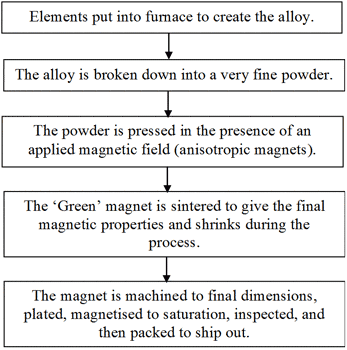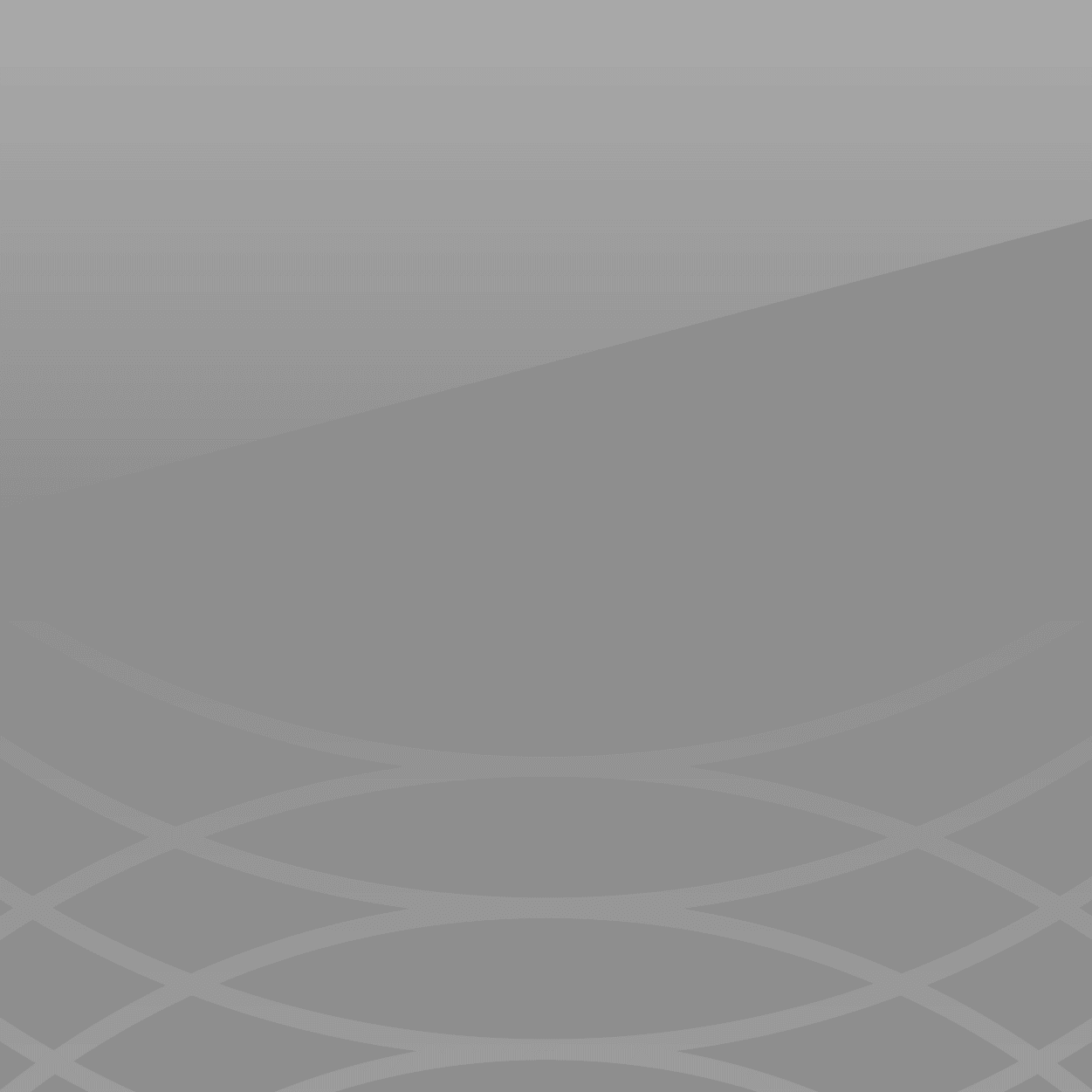How Neodymium NdFeB Magnets are made
The Original Online Magnet Company
Neodymium NdFeB Magnet
Neodymium Iron Boron is an alloy made mainly from a combination of Neodymium, Iron, Boron, Cobalt and varying levels of Dysprosium and Praseodymium
The exact chemical composition within NdFeB depends on the grade of NdFeB. Dysprosium and Praseodymium are added as a replacement for some of the Neodymium to improve the corrosion resistance and to improve the Hci (Intrinsic coercivity) of the "Neo". An example of the composition is given below.
Typical Composition of an NdFeB Alloy
| Main Elements within NdFeB | Percentage by weight |
| Neodymium (Nd) | 29% - 32% |
| Iron (Fe) | 64.2% – 68.5% |
| Boron (B) | 1.0% - 1.2% |
| Aluminium (Al) | 0.2% - 0.4% |
| Niobium (Nb) | 0.5% -1% |
| Dysprosium (Dy) | 0.8% -1.2% |
The Method of Manufacture of Neodymium NdFeB Magnets (Neodymium Iron Boron Magnets) is as follows:
The Neodymium metal element is initially separated from refined Rare Earth oxides in an electrolytic furnace. The "Rare Earth" elements are lanthanoids (also called lanthanides), and the term arises from the uncommon oxide minerals used to isolate the elements. Although the term "Rare Earth" is used, it does not mean that the chemical elements are scarce. Rare Earth elements are abundant, e.g. Neodymium element is more common than gold. The Neodymium, Iron and Boron are measured and put in a vacuum induction furnace to form an alloy. Other elements are added, as required, for specific grades, e.g. Cobalt, Copper, Gadolinium and Dysprosium (e.g. to assist with corrosion resistance). The mixture is melted due to the high-frequency heating and melting.
In simplified terms, the "Neo" alloy is like a cake mixture, with each factory's recipe for each grade. The resultant melted alloy is then cooled to form ingots of alloy. The alloy ingots are then broken down by hydrogen decrepitation (HD) or hydrogenation disproportionation desorption and recombination (HDDR), and jet milled down in a nitrogen and argon atmosphere to a micron-sized powder (about 3 microns or less in size). This Neodymium powder is then fed into a hopper to allow the pressing of magnets.
-
Methods Of Pressing The Powder
There are three main methods of pressing the powder – axial and transverse pressing. Die pressing requires tooling to make a cavity slightly larger than the necessary shape (because sintering causes shrinkage of the magnet). The Neodymium powder enters the die cavity from the hopper and is then compacted in the presence of an externally applied magnetic field. The external field is either applied parallel to the compacting force (this axial pressing is not so standard) or perpendicular to the compaction direction (called transverse pressing). Transverse pressing gives higher magnetic properties for the Neodymium NdFeB Magnets.
The third method of pressing is isostatic pressing. The NdFeB powder is put into a rubber mould and into a sizeable fluid-filled container, increasing the fluid's pressure. Again, an external magnetising field is present, but the NdFeB powder is compacted from all sides. Isostatic pressing gives the best possible magnetic performance for Neodymium Iron Boron. The methods employed vary depending on the grade of "Neo" required and are decided by the manufacturer.
-
Magnetising Field
A solenoid coil set on either side of the compacting powder creates the external magnetising field. The magnetic domains of the NdFeB powder align with the applied magnetising field – the more homogenous the applied field, the more homogenous the magnetic performance of the Neodymium magnet. As the die presses the Neodymium powder, the direction of magnetisation is locked in place – the Neodymium magnet has been given a preferred direction of magnetisation. It is called anisotropic (if no external field were applied, it would be possible to magnetise the magnet in any direction, which is called isotropic, but the magnetic performance would be much lower than that of an anisotropic magnet and is usually confined to bonded magnets).
Rare Earth magnets exhibit uniaxial magnetocrystalline anisotropy, i.e. they have a unique axis crystal structure corresponding with the easy axis of magnetisation. In the case of Nd2Fe14B, the easy axis of magnetisation is the c-axis of the complex tetragonal structure. In the presence of an external magnetising field, it aligns along the c-axis, becoming capable of being fully magnetised to saturation with very high coercivity.
-
The Sintering Process
Before the pressed NdFeB magnet is released, it is given a demagnetising pulse to leave it unmagnetised. The compacted magnet is termed a 'green' magnet – it is easy to force to crumble apart, and its magnetic performance is not good. The 'green' Neodymium magnet is sintered to give it its final magnetic properties.
The sintering process is carefully monitored (a strict temperature and time profile have to be applied) and occurs in an inert (oxygen-free) atmosphere (e.g. argon). If oxygen is present, the resultant oxides destroy the magnetic performance of the NdFeB. The sintering process also causes shrinkage of the magnet as the powder fuses together. The shrinkage gives a magnet close to the required shape, but the shrinkage is usually uneven (e.g. a ring may shrink to become an oval).
At the end of the sintering process, a final rapid quench is applied to cool the magnet rapidly. This minimises the unwanted production of 'phases' (in simplified terms, variants of the alloy with poor magnetic properties) that occur below the sintering temperature. A rapid quench maximises the magnetic performance of NdFeB. Because the sintering process causes an uneven shrinkage, the shape of the Neodymium magnet will not be to the required dimensions.
-
Tolerances and Dimensions
The next stage is to machine the magnets to the required tolerances. Because machining is needed, the Neodymium magnets are made slightly larger when pressed, e.g. larger outer diameter, smaller inner diameter and taller for a ring magnet. Standard magnet dimensional tolerances are +/-0.1mm, although +/-0.05mm is achievable at extra cost. The possibility of even tighter tolerances depends on the shape and size of the magnet and may not be possible.
For note, the Neodymium magnet is rigid. Cutting holes in NdFeB with a standard drill or carbide tip will blunt the drill bit. Diamond-cutting tools (CNC diamond grinding wheels, diamond drills, etc.) and wire-cutting machines (EDM) must be used. The NdFeB swarf powder produced during machining needs to be cooled by liquid. Otherwise, it may spontaneously combust. For Neodymium block magnets, there may be cost savings in using much larger magnet blocks made by isostatic pressing and cutting them into smaller Neodymium blocks of the desired size. This is done for speed and mass production (where enough cutting and grinding machines are present) and is known as "slice and dice". Once the final dimensions for the magnet have been met by machining, the Neodymium magnet is given a protective coating. This is usually a Ni-Cu-Ni coating.
-
Coating
The magnet must be cleaned to remove any swarf/powder from machining. It is then dried thoroughly before being plated. It is imperative that the drying is thorough. Otherwise, water is locked into the plated Neodymium magnet, and the magnet will corrode from the inside out. The plating is very thin, e.g. 15-35 microns for Ni-Cu-Ni (1 micron is 1/1000mm).
The current range of coatings available are as follows:- Nickel-Copper-Nickel (Ni-Cu-Ni) [standard], Epoxy, Zinc (Zn), Gold (Au), Silver (Ag), Tin (Sn), Titanium (Ti), Titanium Nitride (TiN), Parylene C, Everlube, Chrome, PTFE ("Teflon"; white, black, grey, silvery), Ni-Cu-Ni plus Epoxy, Ni-Cu-Ni plus Rubber, Zn plus Rubber, Ni-Cu-Ni plus Parylene C, Ni-Cu-Ni plus PTFE, Tin (Sn) plus Parylene C, Zinc Chromate, Phosphate Passivation and Uncoated (i.e. bare – not recommended but is sometimes required by the customer).
Other coatings may be possible. It is not recommended to use the magnet without a protective layer.
Higher Hci Neodymium NdFeB magnets are said to be better at corrosion resistance, but this does not guarantee safe use when unplated. If necessary, plate the magnets after assembly (this is because any glue would adhere to the plating rather than the NdFeB magnet, so if the plating fails, the magnet becomes free). Removing the plating to allow better glue adhesion is possible. Still, corrosion resistance in the Neodymium magnet may be severely compromised during such a process unless great care is taken during assembly (protective sleeves may be worth considering to ensure the magnets stay in place, e.g. carbon fibre sleeve for rotors).
Table Comparing Main NdFeB Coating Types
COATING APPLIED |
NICKEL |
EPOXY RESIN |
Ni + EPOXY |
|||
Electroless |
Powder Spray |
E-Coating |
Nickel plating |
|||
Coating Thickness |
Range (microns) |
12 to 25 |
25 to 40 |
20 to 40 |
15 to 25 |
25 to 40 |
| Homogeneity | Excellent | Good | Poor | Excellent | Good | |
| Effectiveness versus Magnet Size | Small (<20 grams) | Excellent | Good | Fair | Good | Good |
| Large (>20 grams) | Fair to Good | Good | Fair | Good | Good | |
| Hours before coating is likely to fail | Temp. & Humidity (60ºC, 95%RH) | >2500 | >500 | >1500 | >2500 | |
| Temp. & Humidity (85ºC, 85%RH) | >500 | >100 | >300 | >500 | ||
| Salt Spray (35ºC, 5% NaCl) | >48 | <24 | >100 | >200 | ||
| Coating Colour | Silver | Silver | Black | Black | Black | |
| Heat Cycle | Fair | Fair | Fair | Fair | Fair | |
| Heat Resistance | Poor | Poor | Poor | Poor | Poor | |
| Collision Test | Fair | Fair | Fair | Fair | Fair | |
| Film to material adhesion test | Fair | Fair | Fair | Fair | Fair | |
| Glue adhesion test | Fair | Fair | Fair | Fair | Fair | |
| Tolerance accuracy | Excellent | Excellent | Fair | Fair | Fair to Poor | |
| Additional Remarks | 15-30 microns Ni-Cu-Ni Standard coating | Epoxy resins are not hermetic | Thickness buildup can be a problem | |||
-
Magnetising
Once plated, the Neodymium NdFeB magnet is then magnetised. The Neodymium magnet is placed in a solenoid coil, which is energised to produce a field at least three times the value of the magnet's Hci. It is not unusual for Rare Earth magnets to be 'hit' with a field of 5T. The Rare Earth magnets sometimes have to be physically held within the coil. Otherwise, the magnet may react to the applied magnetising pulse and be propelled out of the ring (a bit like a bullet).
The Neodymium magnet, being anisotropic, has a direction of magnetisation locked within its structure. When being magnetised, this direction of magnetisation within the structure aligns with the magnetising field. If the magnet is not aligned with the magnetising field, the magnet will violently spin to align up. The magnet can break up / shatter due to the high rotational forces acting on the domains within the magnet. The magnet must be magnetised to saturation to get the maximum performance output. If the magnet is not aligned with the magnetising field, full saturation of Neodymium may not be achieved.
The Neodymium magnet comprises multiple domains (in simple terms, think of these as miniature magnets that make up the entire magnet). A tiny proportion of domains are 'weak', and these 'relax' soon after the magnetisation. This is natural and cannot be avoided. The output drop is minimal (much less than 0.5 % typically) and occurs very soon after being magnetised to saturation (it will have happened before the magnets have been packed for dispatch). Once done, the output of the NdFeB will not fall any further except by external demagnetising fields, raised temperatures, radiation or corrosion.
-
Final Processes
The Neodymium magnets are given quality control checks throughout the entire production process (dimensional checks, magnetic checks, visual checks). After magnetising, the magnets are given a final check (they are tested for magnetic performance and are visually checked and dimensionally checked) and then packaged for shipping to the customer after passing the quality control inspection tests.
Summary of Production of NdFeB magnets

Call us today on 01442 875081 or email on eMagnets@buntingmagnetics.com
Discover More
Get in touch today
Please do not hesitate to contact us with any question or query you may have. Our professional team will give you expert advice and guidance for your magnetic application and equipment.


